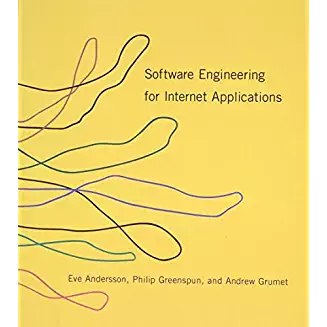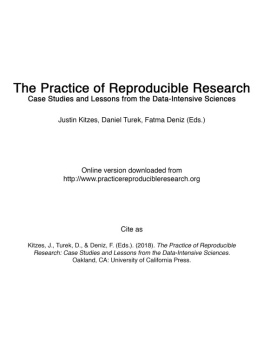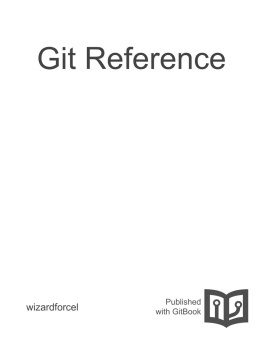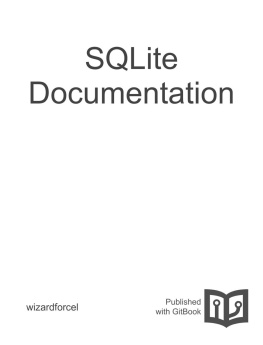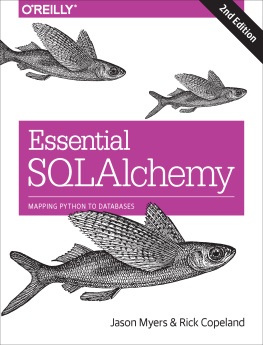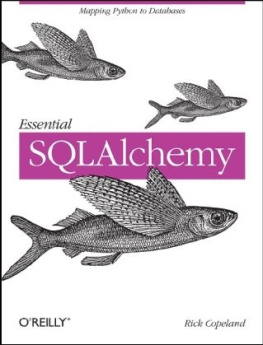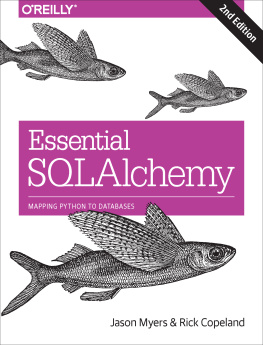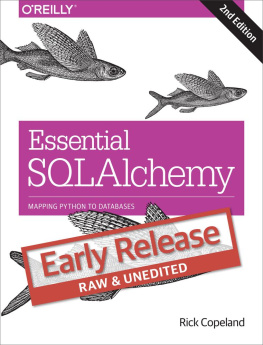it-ebooks - SQLAlchemy 1.1 Documentation
Here you can read online it-ebooks - SQLAlchemy 1.1 Documentation full text of the book (entire story) in english for free. Download pdf and epub, get meaning, cover and reviews about this ebook. year: 2017, publisher: iBooker it-ebooks, genre: Computer. Description of the work, (preface) as well as reviews are available. Best literature library LitArk.com created for fans of good reading and offers a wide selection of genres:
Romance novel
Science fiction
Adventure
Detective
Science
History
Home and family
Prose
Art
Politics
Computer
Non-fiction
Religion
Business
Children
Humor
Choose a favorite category and find really read worthwhile books. Enjoy immersion in the world of imagination, feel the emotions of the characters or learn something new for yourself, make an fascinating discovery.

SQLAlchemy 1.1 Documentation: summary, description and annotation
We offer to read an annotation, description, summary or preface (depends on what the author of the book "SQLAlchemy 1.1 Documentation" wrote himself). If you haven't found the necessary information about the book — write in the comments, we will try to find it.
SQLAlchemy 1.1 Documentation — read online for free the complete book (whole text) full work
Below is the text of the book, divided by pages. System saving the place of the last page read, allows you to conveniently read the book "SQLAlchemy 1.1 Documentation" online for free, without having to search again every time where you left off. Put a bookmark, and you can go to the page where you finished reading at any time.
Font size:
Interval:
Bookmark:
This feature allows the value of a database column to be set to a SQLexpression instead of a literal value. Its especially useful for atomicupdates, calling stored procedures, etc. All you do is assign an expression toan attribute:
This technique works both for INSERT and UPDATE statements. After theflush/commit operation, the value attribute on someobject above isexpired, so that when next accessed the newly generated value will be loadedfrom the database.
SQL expressions and strings can be executed via the:
The current method:
The examples above deal with a instance, which is used to locate theproper context for the desired engine:
The ORM considers any attribute that was never set on an object as adefault case; the attribute will be omitted from the INSERT statement:
Omitting a column from the INSERT means that the column willhave the NULL value set, unless the column has a default set up,in which case the default value will be persisted. This holds trueboth from a pure SQL perspective with server-side defaults, as well as thebehavior of SQLAlchemys insert behavior with both client-side and server-sidedefaults:
However, in the ORM, even if one assigns the Python value None explicitlyto the object, this is treated the same as though the value were neverassigned:
The above operation will persist into the data column theserver default value of "default" and not SQL NULL, even though None was passed; this is a long-standing behavior of the ORM that many applicationshold as an assumption.
So what if we want to actually put NULL into this column, even though thecolumn has a default value? There are two approaches. One is thaton a per-instance level, we assign the attribute using the SQL construct:
The SQL construct always translates into the SQLNULL value being directly present in the target INSERT statement.
If wed like to be able to use the Python value None and have thisalso be persisted as NULL despite the presence of column defaults,we can configure this for the ORM using a Core-level modifier, which indicatesa type where the ORM should treat the value None the same as any othervalue and pass it through, rather than omitting it as a missing value:
Evaluating None
The modifier is primarily intended tosignal a type where the Python value None is significant, the primaryexample being a JSON type which may want to persist the JSON null valuerather than SQL NULL. We are slightly repurposing it here in order tosignal to the ORM that wed like None to be passed into the type wheneverpresent, even though no special type-level behaviors are assigned to it.
New in version 1.1: added the methodin order to indicate that a None value should be treated as significant.
Vertical partitioning places different kinds of objects, or different tables,across multiple databases:
Above, operations against either class will make usage of the linked to that class. Upon a flush operation, similar rules take placeto ensure each class is written to the right database.
The transactions among the multiple databases can optionally be coordinatedvia two phase commit, if the underlying backend supports it. See for an example.
More comprehensive rule-based class-level partitioning can be built byoverriding the which delivers the following rules:
- Flush operations are delivered to the engine named
master. - Operations on objects that subclass
MyOtherClassalloccur on theotherengine. - Read operations for all other classes occur on a randomchoice of the
slave1orslave2database.
Font size:
Interval:
Bookmark:
Similar books «SQLAlchemy 1.1 Documentation»
Look at similar books to SQLAlchemy 1.1 Documentation. We have selected literature similar in name and meaning in the hope of providing readers with more options to find new, interesting, not yet read works.
Discussion, reviews of the book SQLAlchemy 1.1 Documentation and just readers' own opinions. Leave your comments, write what you think about the work, its meaning or the main characters. Specify what exactly you liked and what you didn't like, and why you think so.



